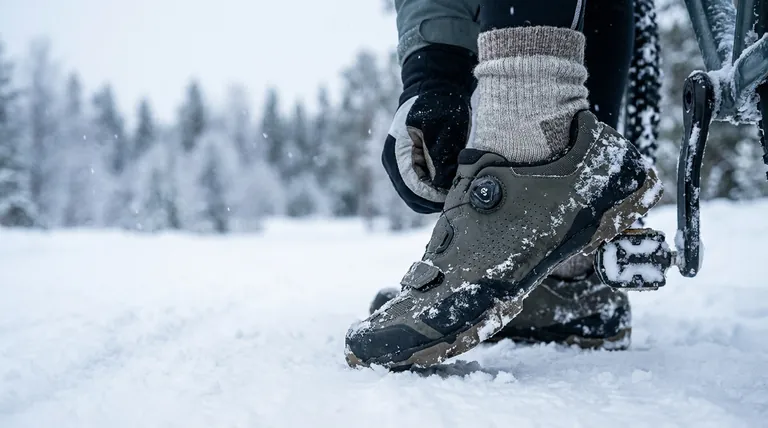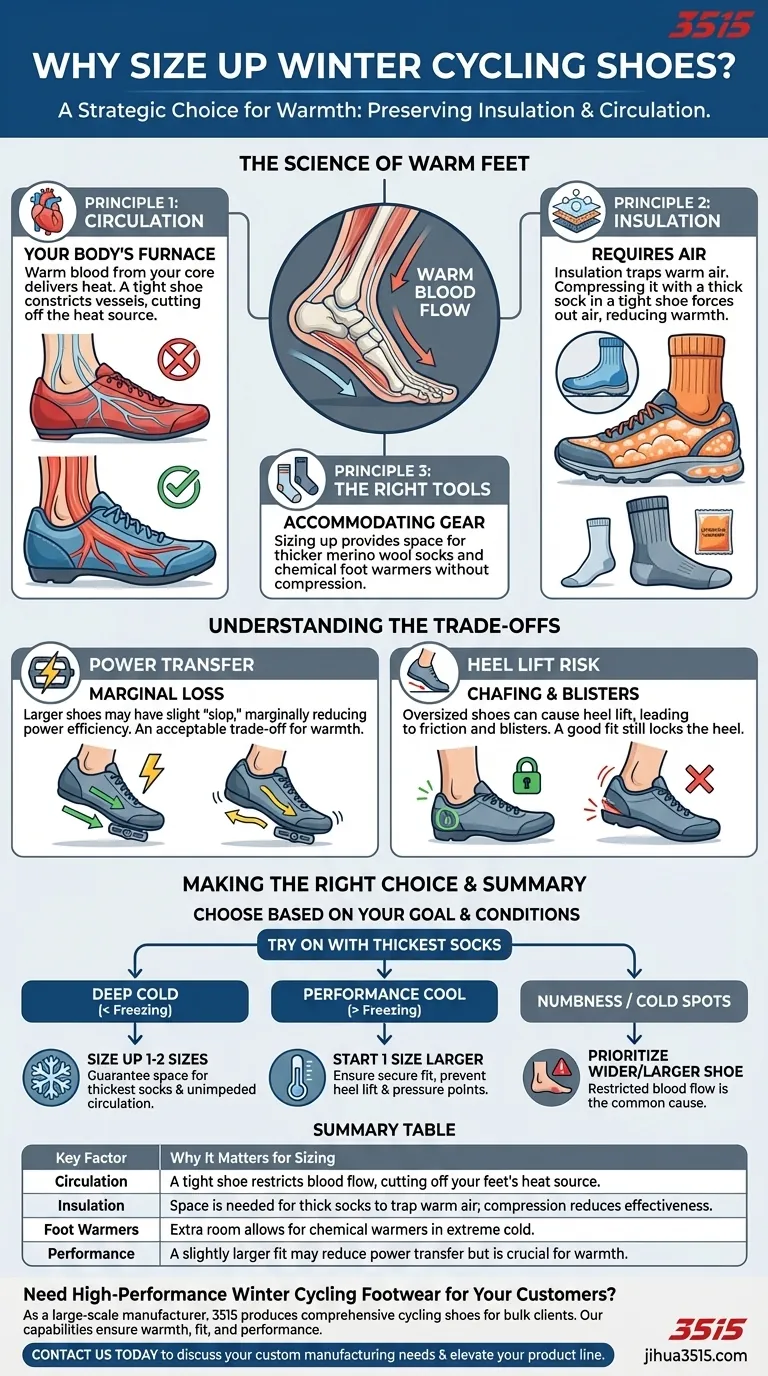Sizing up your winter cycling shoes is a foundational principle for staying warm, but the reason goes far beyond simply fitting thicker socks. It is a strategic choice to create an environment inside your shoe that preserves your body's two primary defenses against the cold: insulation and circulation.
The core principle is this: your feet stay warm from the heat your body generates, not from the shoe itself. Sizing up ensures this heat can reach your feet via good circulation and remain there thanks to an uncompressed layer of insulation.

The Science of Keeping Feet Warm
To understand the sizing recommendation, you must first understand the two systems that fail when your feet get cold. One is physiological (blood flow), and the other is physical (insulation).
Principle 1: Circulation Is Your Body's Furnace
Your body’s primary heating system is your circulatory system. Warm blood flows from your core to your extremities, delivering the heat needed to keep them functional.
A shoe that is too tight, even slightly, constricts the thousands of small blood vessels in your feet. This restriction acts like a valve, reducing the flow of warm blood and effectively cutting your feet off from their heat source.
Principle 2: Insulation Requires Air
Insulation, whether it's the material in the shoe or the wool in your sock, doesn't create heat. It works by trapping a layer of air, which your body then warms up.
When you compress insulation by stuffing a thick sock into a tight shoe, you force out these crucial air pockets. This dramatically reduces the sock's insulating properties, rendering it far less effective.
Principle 3: Accommodating the Right Tools
Winter riding requires different equipment. A thick merino wool sock takes up significantly more volume than a thin summer sock.
Sizing up provides the necessary space to accommodate these thicker socks without causing the compression and circulation issues mentioned above. It can also leave room for chemical foot warmers for the most extreme conditions.
Understanding the Trade-offs
Sizing up is not without its compromises. The goal is to create space for warmth, not to have a sloppy, inefficient fit.
The Impact on Power Transfer
A performance cycling shoe is designed to be snug, minimizing any movement of the foot to ensure every watt of power is transferred directly to the pedals.
A larger winter shoe can introduce a small amount of foot movement, or "slop," which may lead to a marginal loss of power transfer efficiency. For most winter training, this is an acceptable trade-off for comfort and warmth.
The Risk of Heel Lift
The most common issue with an oversized shoe is heel lift. As you pull up on the pedal stroke, your heel may lift away from the insole.
This not only reduces efficiency but can also cause friction, leading to chafing and blisters. A good fit means accommodating winter socks while still ensuring the heel is locked securely in place.
Making the Right Choice for Your Goal
When trying on shoes, always do so with the thickest socks you intend to wear for winter riding. Your decision should be based on your specific needs.
- If your primary focus is riding in deep cold (below freezing): Err on the side of sizing up one to two full sizes to guarantee space for the thickest socks and unimpeded circulation.
- If your primary focus is performance in cool conditions (above freezing): Start by trying one size larger, ensuring a secure fit with your winter socks that prevents heel lift and pressure points.
- If you frequently experience numbness or cold spots: Prioritize a wider or larger shoe, as restricted blood flow is the most common cause of these issues.
Ultimately, a proper fit allows you to generate and retain heat, turning a miserable ride into a productive one.
Summary Table:
| Key Factor | Why It Matters for Sizing |
|---|---|
| Circulation | A tight shoe restricts blood flow, cutting off your feet's heat source. |
| Insulation | Space is needed for thick socks to trap warm air; compression reduces effectiveness. |
| Foot Warmers | Extra room allows for chemical warmers in extreme cold. |
| Performance Trade-off | A slightly larger fit may reduce power transfer but is crucial for warmth. |
Need High-Performance Winter Cycling Footwear for Your Customers?
As a large-scale manufacturer, 3515 produces a comprehensive range of cycling shoes and boots for distributors, brand owners, and bulk clients. Our production capabilities ensure your footwear meets the precise balance of warmth, fit, and performance that cyclists demand.
Contact us today to discuss your custom manufacturing needs and elevate your product line.
Visual Guide

Related Products
- Durable Waterproof Rain Boots | Custom Manufacturer for Wholesale & Brands
- Safety Footwear Wholesale Manufacturer for Custom OEM/ODM Production
- Premium Suede Sport Safety Shoes for Wholesale & Bulk Orders
- Premium Insulated Safety Boots and Shoes for Wholesale & Bulk Orders
- Advanced KPU Athletic Safety Shoe with Steel Toe Cap Anti-Slip Rotary Lacing System
People Also Ask
- What certifications should you look for when purchasing sustainable Wellington boots? Choose GRS and FSC for verified eco-friendly footwear.
- Are wellies bad for babies and toddlers' feet? A Guide to Safe, Healthy Footwear
- Why are wellies particularly useful for toddlers? Unlock the Key to Messy Play & Development
- Are wellies harmful to toddlers' feet? A Guide to Safe & Healthy Footwear
- What are the risks of having wet feet in cold conditions? Protect Against Hypothermia & Injury



















